remove seats MAZDA MODEL 6 2019 Owner's Manual (in English)
[x] Cancel search | Manufacturer: MAZDA, Model Year: 2019, Model line: MODEL 6, Model: MAZDA MODEL 6 2019Pages: 668, PDF Size: 9.4 MB
Page 14 of 668
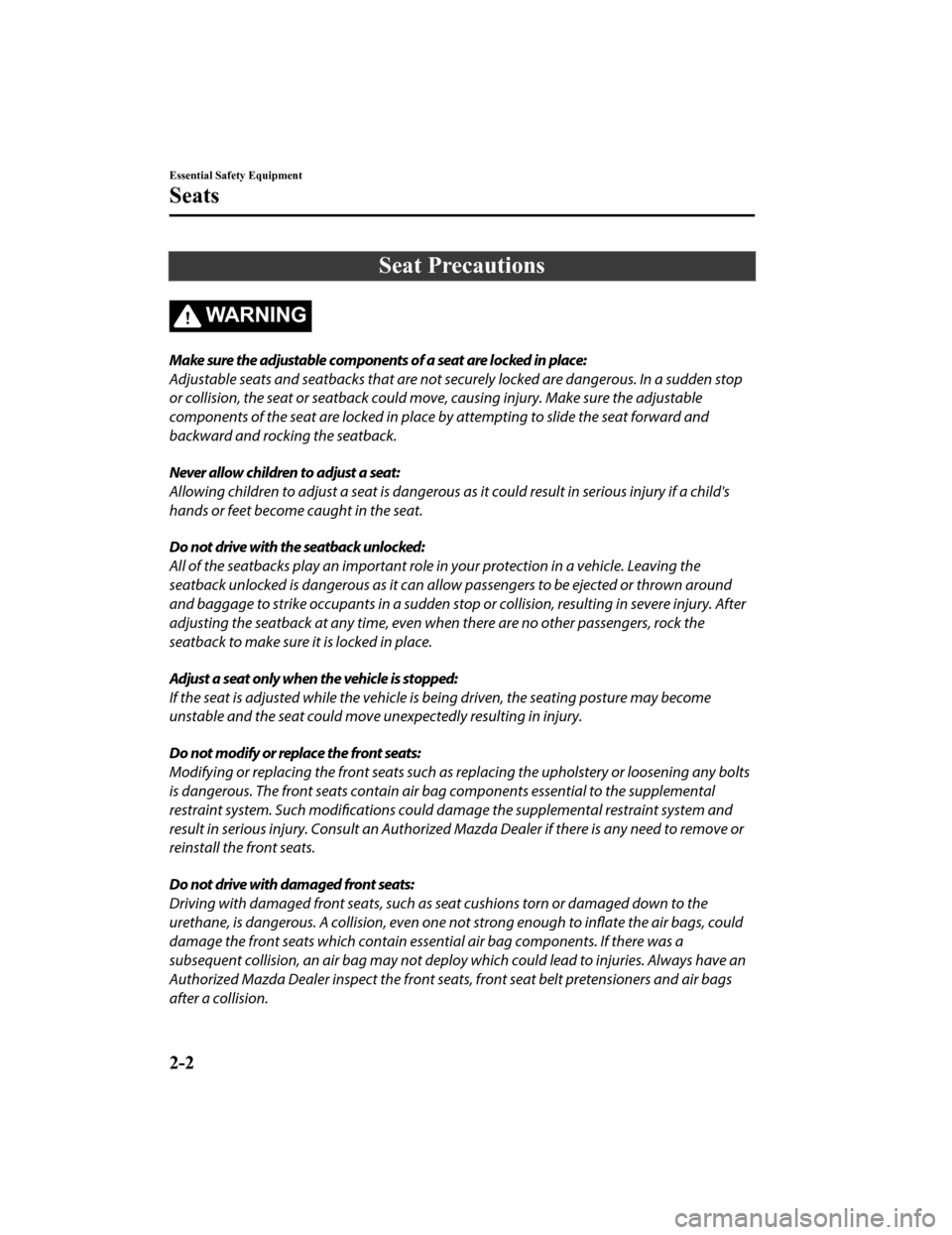
Seat Precautions
WA R N I N G
Make sure the adjustable components of a seat are locked in place:
Adjustable seats and seatbacks that are not securely locked are dangerous. In a sudden stop
or collision, the seat or seatback could move, causing injury. Make sure the adjustable
components of the seat are locked in place by attempting to slide the seat forward and
backward and rocking the seatback.
Never allow children to adjust a seat:
Allowing children to adjust a seat is dangerous as it could result in serious injury if a child's
hands or feet become caught in the seat.
Do not drive with the seatback unlocked:
All of the seatbacks play an important role in your protection in a vehicle. Leaving the
seatback unlocked is dangerous as it can a llow passengers to be ejected or thrown around
and baggage to strike occupants in a sudden stop or collision, resulting in severe injury. After
adjusting the seatback at any time, even when there are no other passengers, rock the
seatback to make sure it is locked in place.
Adjust a seat only when the vehicle is stopped:
If the seat is adjusted while the vehicle is being driven, the seating posture may become
unstable and the seat could move unexpectedly resulting in injury.
Do not modify or replace the front seats:
Modifying or replacing the front seats such as replacing the upholstery or loosening any bolts
is dangerous. The front seats contain air bag components essential to the supplemental
restraint system. Such modifications could damage the supplemental restraint system and
result in serious injury. Consult an Authorized Mazda Dealer if there is any need to remove or
reinstall the front seats.
Do not drive with damaged front seats:
Driving with damaged front seats, such as se at cushions torn or damaged down to the
urethane, is dangerous. A collision, even one not strong enough to
inflate the air bags, could
damage the front seats which contain essential air bag components. If there was a
subsequent collision, an air bag may not deploy which could lead to injuries. Always have an
Authorized Mazda Dealer inspect the front seats, front seat belt pretensioners and air bags
after a collision.
Essential Safety Equipment
Seats
2-2
Mazda6_8HK6-EA-19A_Edition1 2018-11-15 9:36:06
Page 27 of 668
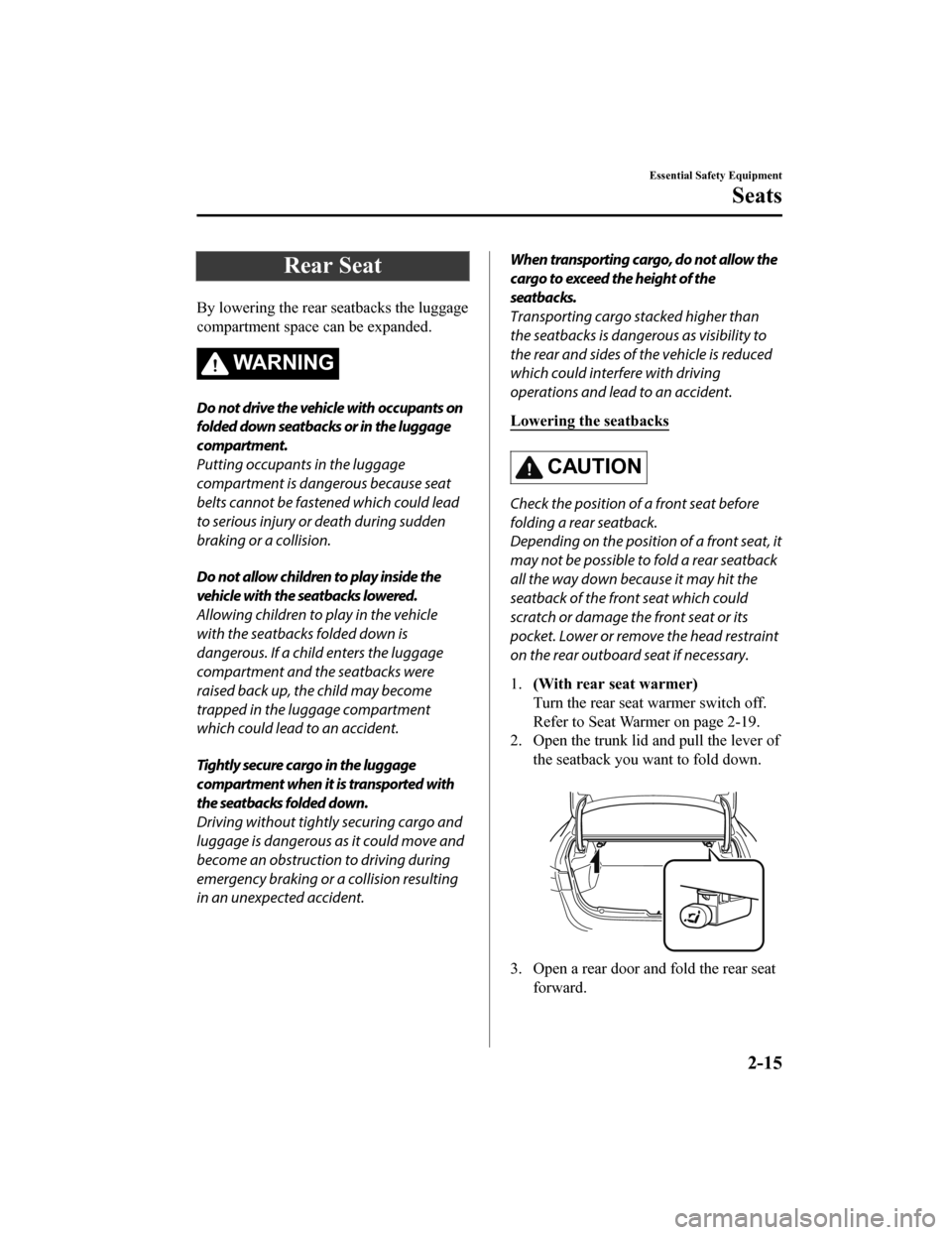
Rear Seat
By lowering the rear seatbacks the luggage
compartment space can be expanded.
WA R N I N G
Do not drive the vehicle with occupants on
folded down seatbacks or in the luggage
compartment.
Putting occupants in the luggage
compartment is dangerous because seat
belts cannot be fastened which could lead
to serious injury or death during sudden
braking or a collision.
Do not allow children to play inside the
vehicle with the seatbacks lowered.
Allowing children to play in the vehicle
with the seatbacks folded down is
dangerous. If a child enters the luggage
compartment and the seatbacks were
raised back up, the child may become
trapped in the luggage compartment
which could lead to an accident.
Tightly secure cargo in the luggage
compartment when it is transported with
the seatbacks folded down.
Driving without tightly securing cargo and
luggage is dangerous as it could move and
become an obstruction to driving during
emergency braking or a collision resulting
in an unexpected accident.
When transporting cargo, do not allow the
cargo to exceed the height of the
seatbacks.
Transporting cargo stacked higher than
the seatbacks is dangerous as visibility to
the rear and sides of the vehicle is reduced
which could interfere with driving
operations and lead to an accident.
Lowering the seatbacks
CAUTION
Check the position of a front seat before
folding a rear seatback.
Depending on the position of a front seat, it
may not be possible to fold a rear seatback
all the way down because it may hit the
seatback of the front seat which could
scratch or damage the front seat or its
pocket. Lower or remove the head restraint
on the rear outboard seat if necessary.
1.(With rear seat warmer)
Turn the rear seat warmer switch off.
Refer to Seat Warm er on page 2-19.
2. Open the trunk lid and pull the lever of
the seatback you want to fold down.
3. Open a rear door an d fold the rear seat
forward.
Essential Safety Equipment
Seats
2-15
Mazda6_8HK6-EA-19A_Edition1 2018-11-15 9:36:06
Page 29 of 668
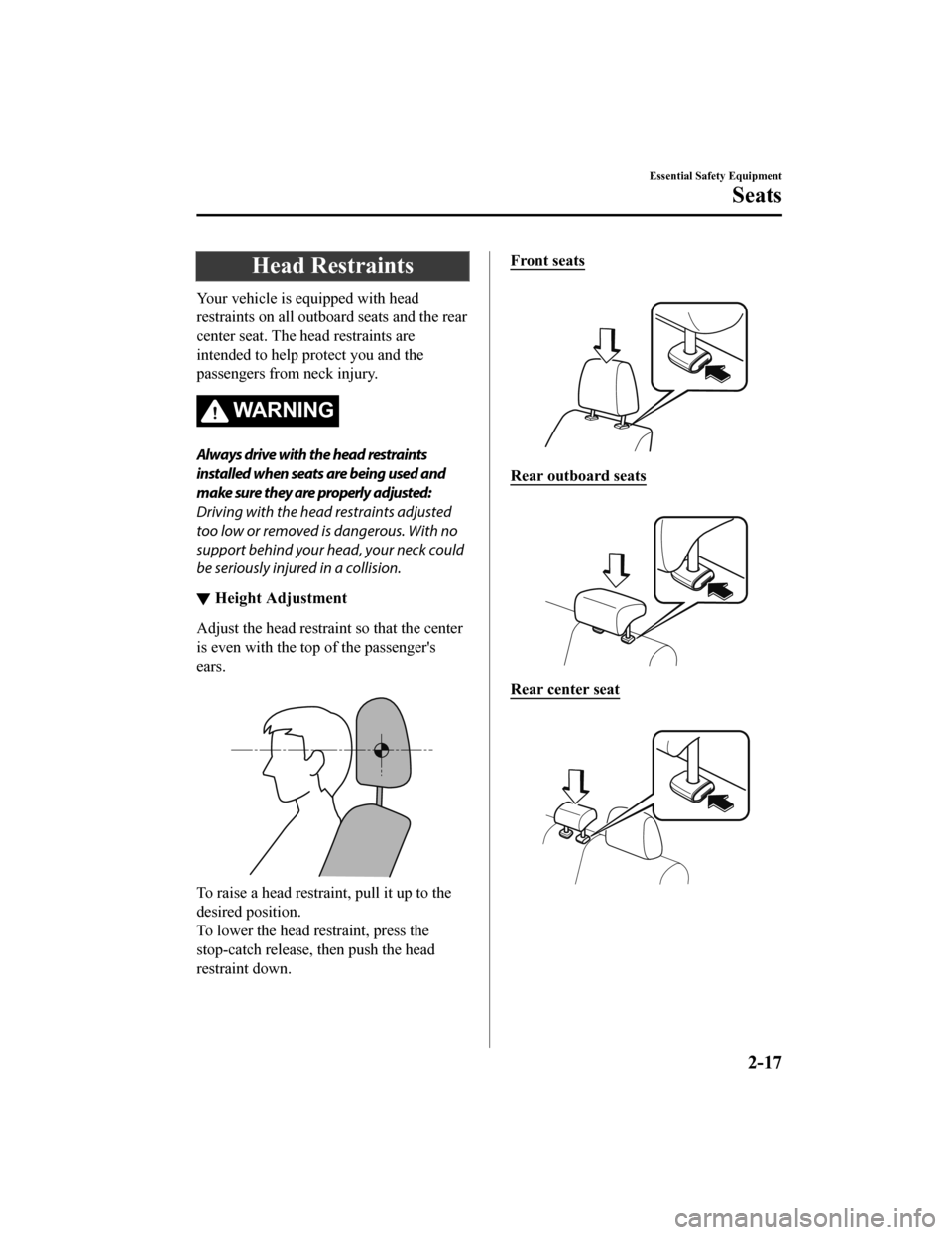
Head Restraints
Your vehicle is equipped with head
restraints on all outboard seats and the rear
center seat. The head restraints are
intended to help protect you and the
passengers from neck injury.
WA R N I N G
Always drive with the head restraints
installed when seats are being used and
make sure they are properly adjusted:
Driving with the head restraints adjusted
too low or removed is dangerous. With no
support behind your he ad, your neck could
be seriously injured in a collision.
▼ Height Adjustment
Adjust the head restraint so that the center
is even with the top of the passenger's
ears.
To raise a head restraint, pull it up to the
desired position.
To lower the head restraint, press the
stop-catch release, then push the head
restraint down.
Front seats
Rear outboard seats
Rear center seat
Essential Safety Equipment
Seats
2-17
Mazda6_8HK6-EA-19A_Edition1
2018-11-15 9:36:06
Page 30 of 668
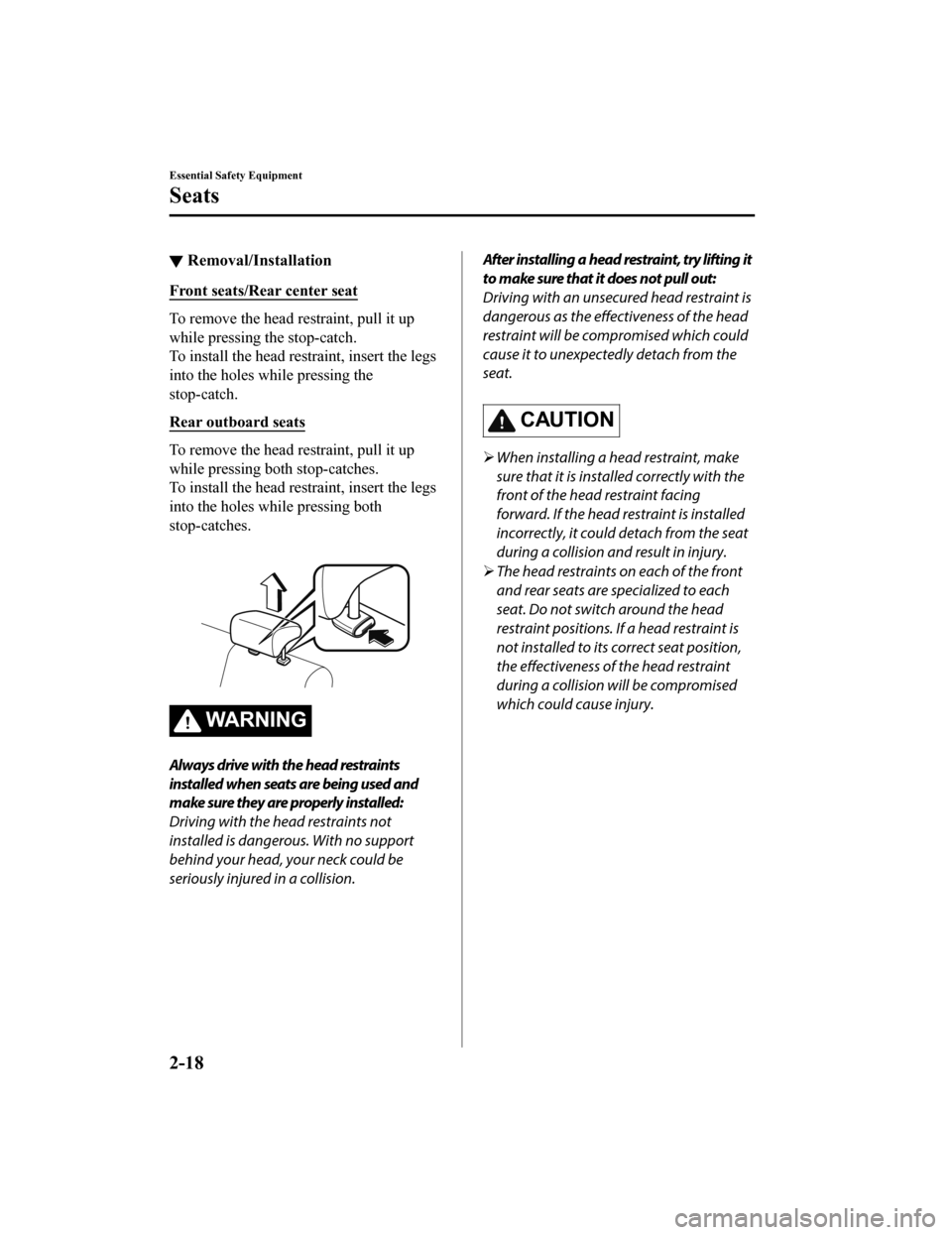
▼Removal/Installation
Front seats/Rear center seat
To remove the head restraint, pull it up
while pressing the stop-catch.
To install the head restraint, insert the legs
into the holes while pressing the
stop-catch.
Rear outboard seats
To remove the head restraint, pull it up
while pressing both stop-catches.
To install the head restraint, insert the legs
into the holes while pressing both
stop-catches.
WA R N I N G
Always drive with the head restraints
installed when seats are being used and
make sure they are properly installed:
Driving with the head restraints not
installed is dangerous. With no support
behind your head, your neck could be
seriously injured in a collision.
After installing a head restraint, try lifting it
to make sure that it does not pull out:
Driving with an unsecured head restraint is
dangerous as the effectiveness of the head
restraint will be compromised which could
cause it to unexpectedly detach from the
seat.
CAUTION
When installing a head restraint, make
sure that it is installed correctly with the
front of the head restraint facing
forward. If the head restraint is installed
incorrectly, it could detach from the seat
during a collision and result in injury.
The head restraints on each of the front
and rear seats are specialized to each
seat. Do not switch around the head
restraint positions. If a head restraint is
not installed to its correct seat position,
the effectiveness of the head restraint
during a collision will be compromised
which could cause injury.
Essential Safety Equipment
Seats
2-18
Mazda6_8HK6-EA-19A_Edition1 2018-11-15 9:36:06
Page 34 of 668
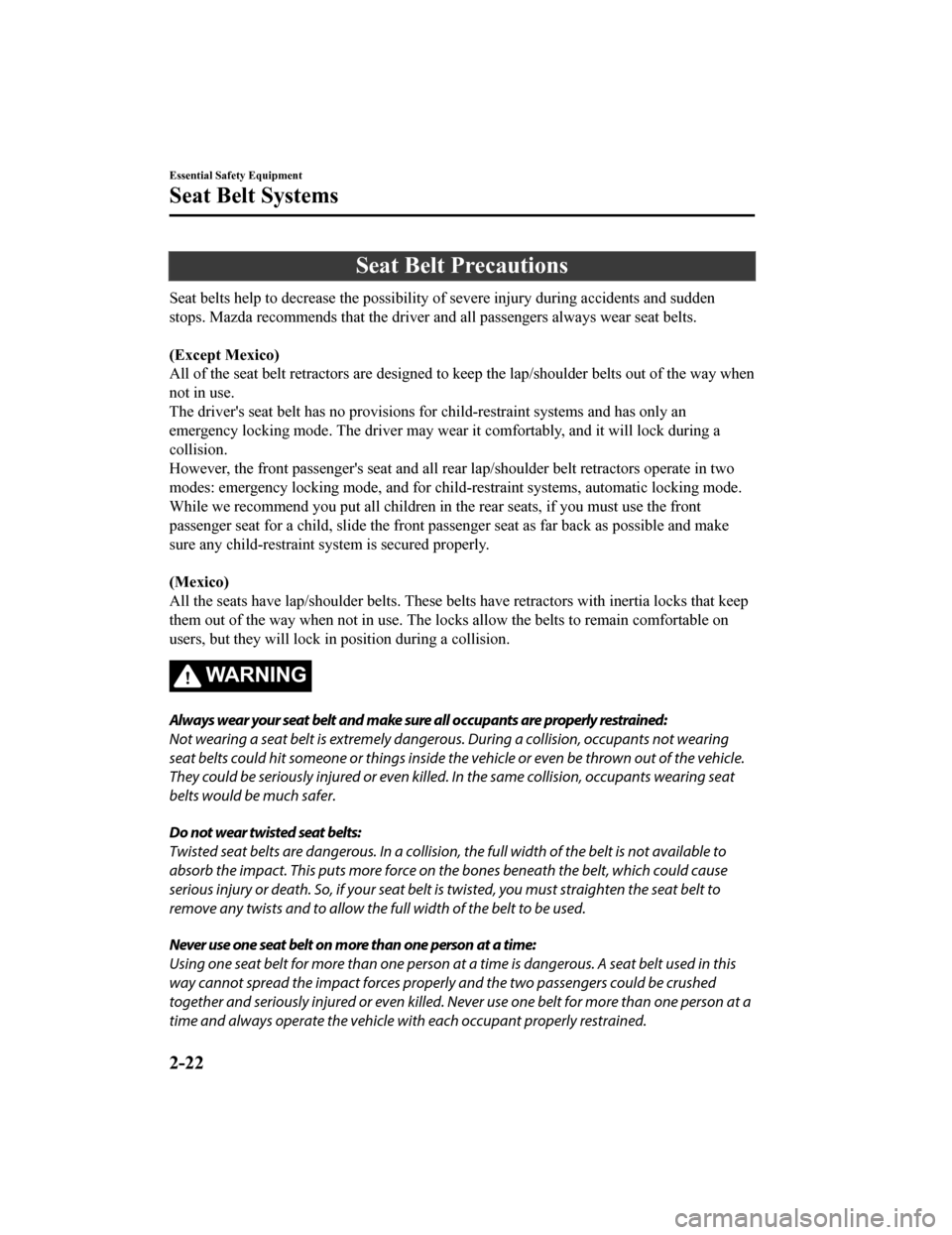
Seat Belt Precautions
Seat belts help to decrease the possibility of severe injury during accidents and sudden
stops. Mazda recommends that the driver and all passengers always wear seat belts.
(Except Mexico)
All of the seat belt retractors are designed to keep the lap/sh oulder belts out of the way when
not in use.
The driver's seat belt has no provisions for child-restraint sy stems and has only an
emergency locking mode. The driver may wear it comfortably, and it will lock during a
collision.
However, the front passenger's seat and all rear lap/shoulder b elt retractors operate in two
modes: emergency locking mode, and for child-restraint systems, automatic locking mode.
While we recommend you put all chi ldren in the rear seats, if you must use the front
passenger seat for a child, slide the front passenger seat as f ar back as possible and make
sure any child-restraint sy stem is secured properly.
(Mexico)
All the seats have lap/shoulder belts. These belts have retract ors with inertia locks that keep
them out of the way when not in use. The locks allow the belts to remain comfortable on
users, but they will lock in position during a collision.
WA R N I N G
Always wear your seat belt and make sure all occupants are properly restrained:
Not wearing a seat belt is extremely dangerous . During a collision, occupants not wearing
seat belts could hit someone or things inside th e vehicle or even be thrown out of the vehicle.
They could be seriously injured or even killed. In the same collision, occupants wearing seat
belts would be much safer.
Do not wear twisted seat belts:
Twisted seat belts are dangerous. In a collision, the full width of the belt is not available to
absorb the impact. This puts more force on the bones beneath the belt, which could cause
serious injury or death. So, if your seat belt is twisted, you must straighten the seat belt to
remove any twists and to allow the full width of the belt to be used.
Never use one seat belt on more than one person at a time:
Using one seat belt for more than one person at a time is dangerous. A seat belt used in this
way cannot spread the impact forces properly and the two passengers could be crushed
together and seriously injured or even killed. Never use one belt for more than one person at a
time and always operate the vehicle with each occupant properly restrained.
Essential Safety Equipment
Seat Belt Systems
2-22
Mazda6_8HK6-EA-19A_Edition1 2018-11-15 9:36:06
Page 52 of 668

Installing Child-RestraintSystems
Accident statistics reveal that a child is
safer in the rear seat . The front passenger's
seat is clearly the worst choice for any
child under 12, and with rear-facing
child-restraint system s it is clearly unsafe
due to air bags.
NOTE
Even if your vehicle is equipped with front
passenger occupant classification sensor
(page 2-67), which automatically
deactivates the front passenger air bag, a
rear seat is the safest place for a child of
any age or size.
Some child-restraint systems now come
with tethers and t herefore must be
installed on the seats that take tethers to be
effective. In your Mazda, tethered
child-restraint systems can only be
accommodated in the three positions on
the rear seat.
Some child-restraint systems also employ
specially designed ISOFIX/LATCH
*1
attachments; refer to "Using ISOFIX
Lower Anchor (Mexico)/Using LATCH
Lower Anchor (Except Mexico)" (page
2-47).
*1 ISOFIX (Mexico)/LATCH (Except Mexico)
WA R N I N G
Tethered Child-Restraint Systems Work
Only on Tether-Equipped Rear Seats:
Installation of a tether equipped
child-restraint system in the front
passenger's seat defeats the safety design
of the system and will result in an increased
chance of serious injury if the
child-restraint system goes forward
without benefit of being tethered.
Place tether equipped child-restraint
systems where there are tether anchors.
▼Anchor Bracket
Anchor brackets for securing
child-restraint systems are equipped in the
vehicle. Locate each anchor position using
the illustration.
To install a child-restraint system, remove
the head restraint. Always follow the
instruction manual accompanying the
child-restraint system.
Anchor bracket location
Use the indicated anchor bracket locations
when installing a ch
ild-restraint system
equipped with a tether.
Anchor bracket For left
For right
For center
*
1
*1
Except Mexico
Essential Safety Equipment
Child Restraint
2-40
Mazda6_8HK6-EA-19A_Edition1 2018-11-15 9:36:06
Page 59 of 668
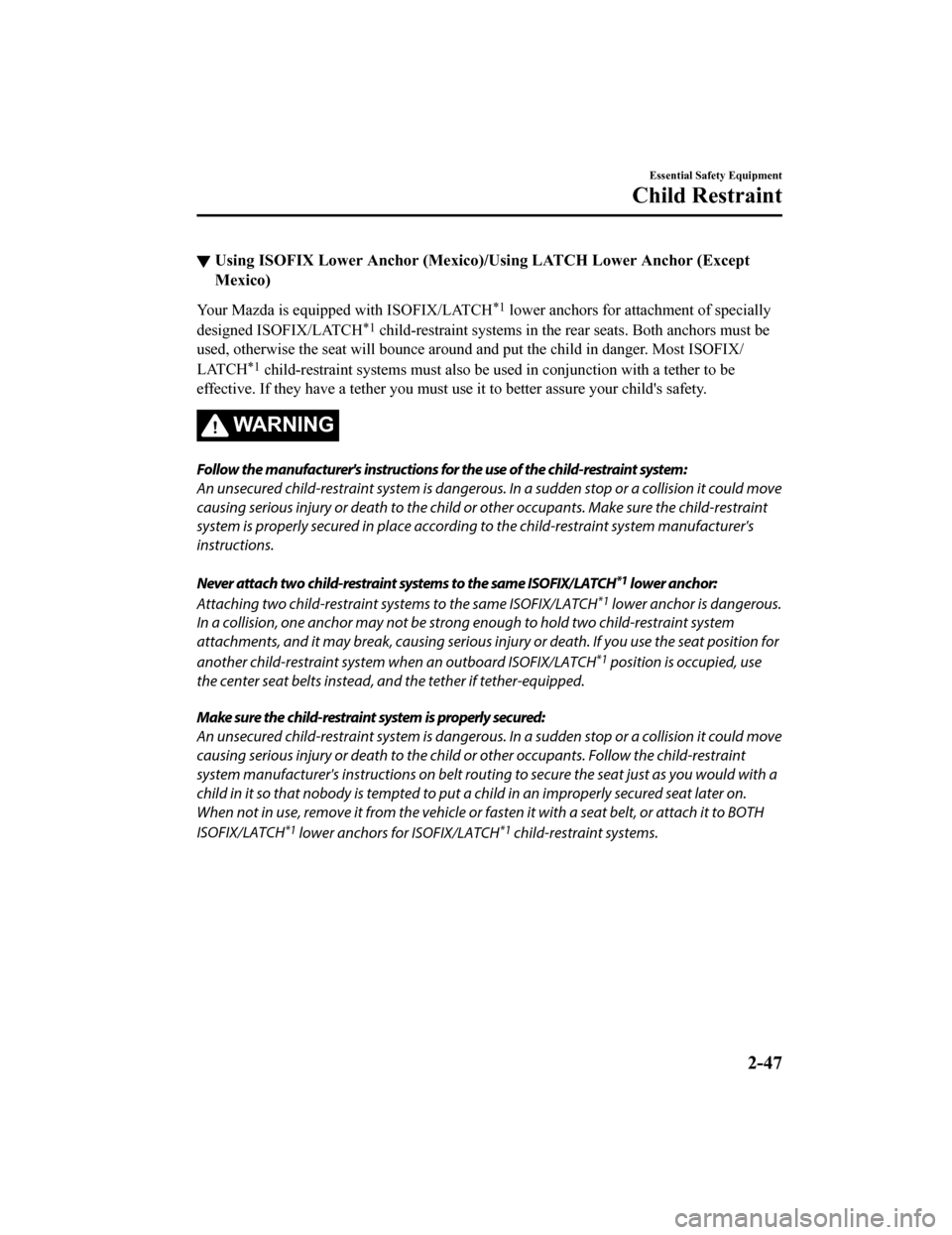
▼Using ISOFIX Lower Anchor (Mexico
)/Using LATCH Lower Anchor (Except
Mexico)
Your Mazda is equipped with ISOFIX/LATCH*1 lower anchors for attachment of specially
designed ISOFIX/LATCH
*1 child-restraint systems in the rear seats. Both anchors must b e
used, otherwise the seat will bounce around and put the child i n danger. Most ISOFIX/
LATCH
*1 child-restraint systems must also be used in conjunction with a tether to be
effective. If they have a tether you must use it to better assure your child's safety.
WA R N I N G
Follow the manufacturer's instructions for the use of the child-restraint system:
An unsecured child-restraint system is dangerous . In a sudden stop or a collision it could move
causing serious injury or death to the child or other occupants. Make sure the child-restraint
system is properly secured in place accordin g to the child-restraint system manufacturer's
instructions.
Never attach two child-restraint systems to the same ISOFIX/LATCH
*1 lower anchor:
Attaching two child-restraint systems to the same ISOFIX/LATCH
*1 lower anchor is dangerous.
In a collision, one anchor may not be strong enough to hold two child-restraint system
attachments, and it may break, causing serious inju ry or death. If you use the seat position for
another child-restraint system when an outboard ISOFIX/LATCH
*1 position is occupied, use
the center seat belts instead, and the tether if tether-equipped.
Make sure the child-restraint system is properly secured:
An unsecured child-restraint system is dangerous . In a sudden stop or a collision it could move
causing serious injury or death to the child or other occupants. Follow the child-restraint
system manufacturer's instructions on belt routin g to secure the seat just as you would with a
child in it so that nobody is tempted to put a child in an improperly secured seat later on.
When not in use, remove it from the vehicle or fasten it with a seat belt, or attach it to BOTH
ISOFIX/LATCH
*1 lower anchors for ISOFIX/LATCH*1 child-restraint systems.
Essential Safety Equipment
Child Restraint
2-47
Mazda6_8HK6-EA-19A_Edition1 2018-11-15 9:36:06
Page 61 of 668
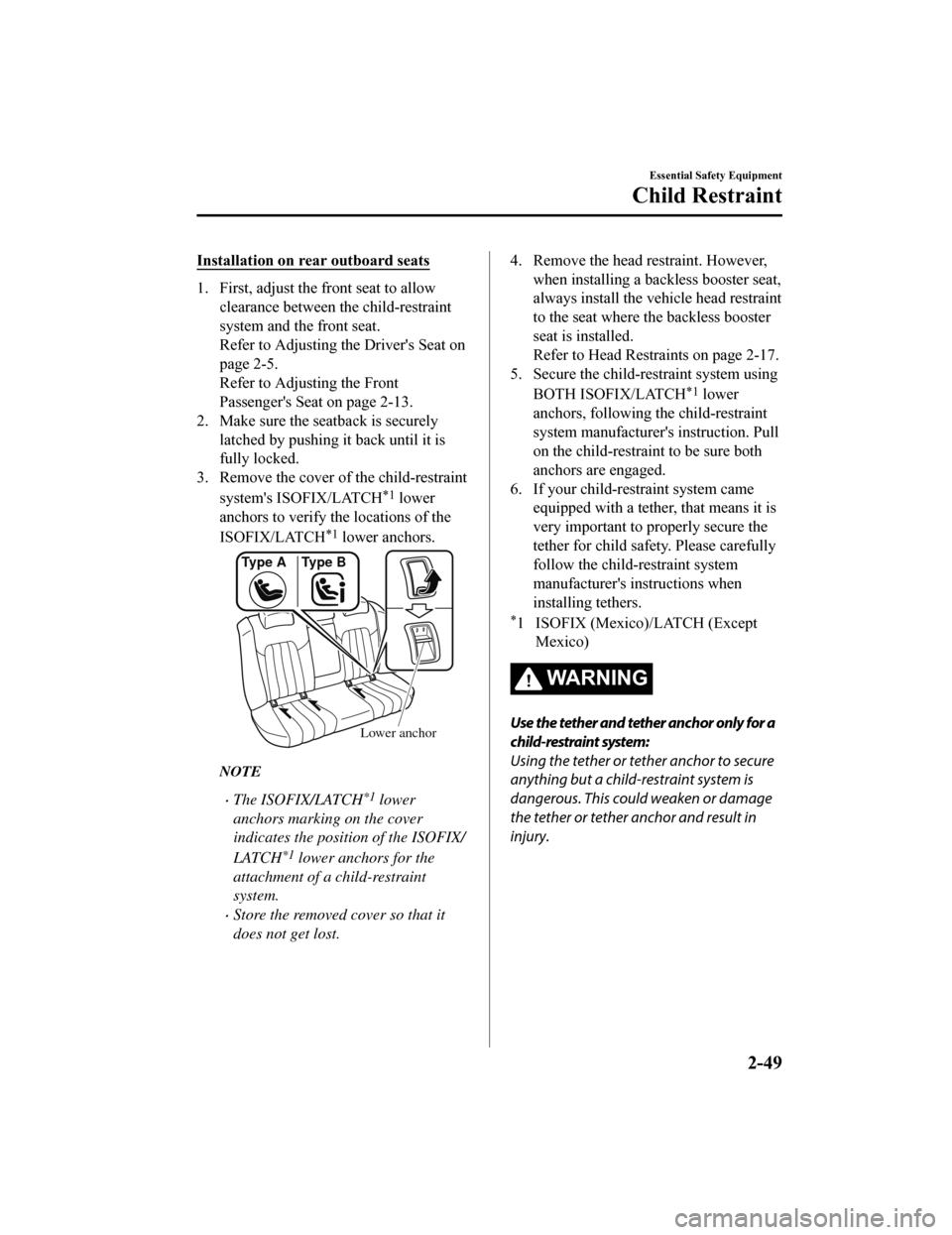
Installation on rear outboard seats
1. First, adjust the front seat to allowclearance between the child-restraint
system and the front seat.
Refer to Adjusting the Driver's Seat on
page 2-5.
Refer to Adjusting the Front
Passenger's Seat on page 2-13.
2. Make sure the seatback is securely latched by pushing it back until it is
fully locked.
3. Remove the cover of the child-restraint
system's ISOFIX/LATCH
*1 lower
anchors to verify th e locations of the
ISOFIX/LATCH
*1 lower anchors.
Lower anchor
Type A Type B
NOTE
The ISOFIX/LATCH*1 lower
anchors marking on the cover
indicates the position of the ISOFIX/
LATCH
*1 lower anchors for the
attachment of a child-restraint
system.
Store the removed cover so that it
does not get lost.
4. Remove the head restraint. However, when installing a backless booster seat,
always install the vehicle head restraint
to the seat where the backless booster
seat is installed.
Refer to Head Restra ints on page 2-17.
5. Secure the child-restraint system using
BOTH ISOFIX/LATCH
*1 lower
anchors, following the child-restraint
system manufacturer's instruction. Pull
on the child-restrain t to be sure both
anchors are engaged.
6. If your child-restraint system came equipped with a teth er, that means it is
very important to properly secure the
tether for child safety. Please carefully
follow the child -restraint system
manufacturer's instructions when
installing tethers.
*1 ISOFIX (Mexico)/LATCH (Except Mexico)
WA R N I N G
Use the tether and tether anchor only for a
child-restraint system:
Using the tether or tether anchor to secure
anything but a child-restraint system is
dangerous. This could weaken or damage
the tether or tether anchor and result in
injury.
Essential Safety Equipment
Child Restraint
2-49
Mazda6_8HK6-EA-19A_Edition1 2018-11-15 9:36:06
Page 62 of 668
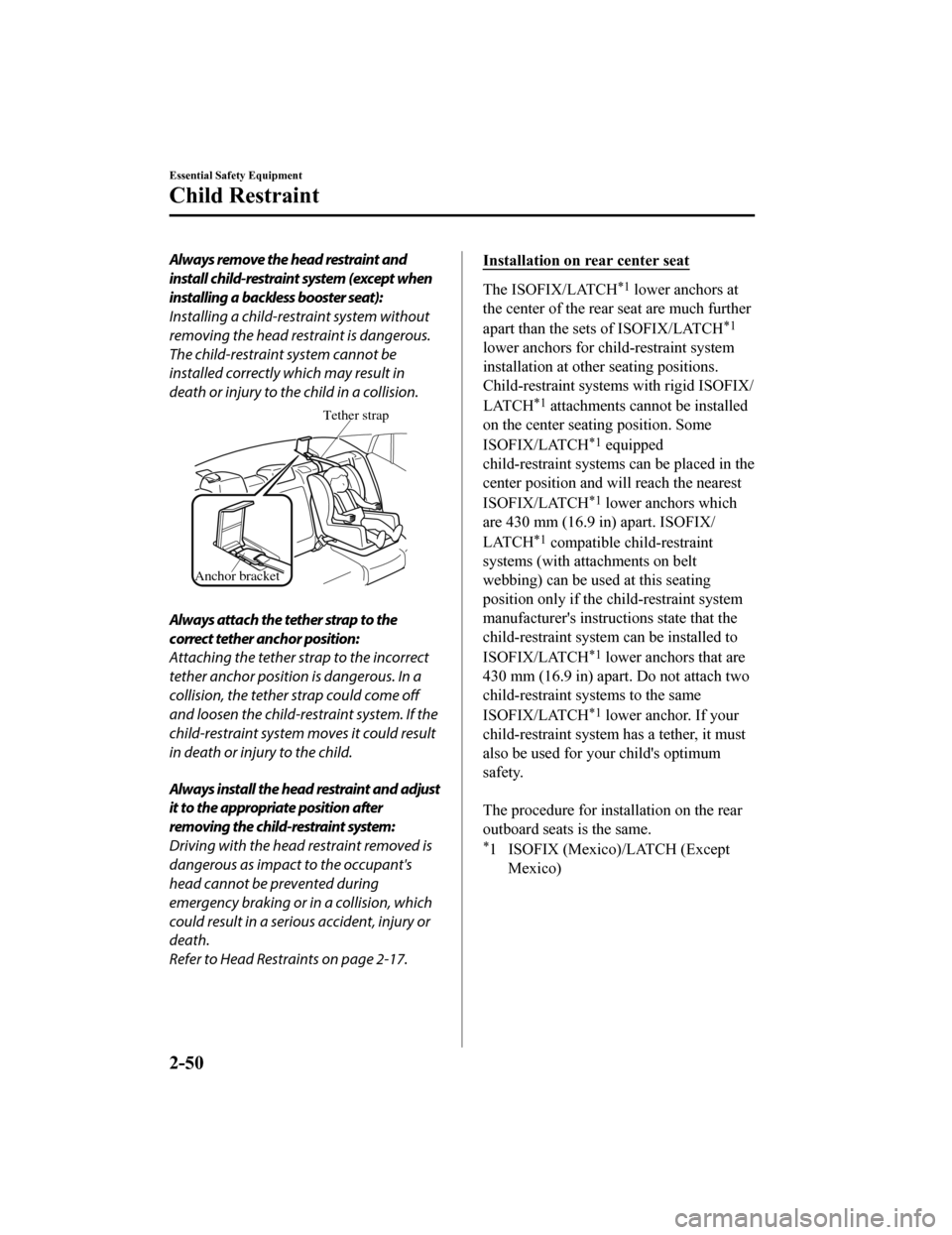
Always remove the head restraint and
install child-restraint system (except when
installing a backless booster seat):
Installing a child-restraint system without
removing the head restraint is dangerous.
The child-restraint system cannot be
installed correctly which may result in
death or injury to the child in a collision.
Anchor bracket
Tether strap
Always attach the tether strap to the
correct tether anchor position:
Attaching the tether strap to the incorrect
tether anchor position is dangerous. In a
collision, the tether strap could come off
and loosen the child-restraint system. If the
child-restraint system moves it could result
in death or injury to the child.
Always install the head restraint and adjust
it to the appropriate position after
removing the child-restraint system:
Driving with the head restraint removed is
dangerous as impact to the occupant's
head cannot be prevented during
emergency braking or in a collision, which
could result in a serious accident, injury or
death.
Refer to Head Restraints on page 2-17.
Installation on rear center seat
The ISOFIX/LATCH*1 lower anchors at
the center of the rear seat are much further
apart than the sets of ISOFIX/LATCH
*1
lower anchors for child-restraint system
installation at other seating positions.
Child-restraint systems with rig id ISOFIX/
LATCH
*1 attachments cannot be installed
on the center seating position. Some
ISOFIX/LATCH
*1 equipped
child-restraint system s can be placed in the
center position and wi ll reach the nearest
ISOFIX/LATCH
*1 lower anchors which
are 430 mm (16.9 in) apart. ISOFIX/
LATCH
*1 compatible child-restraint
systems (with attachments on belt
webbing) can be us ed at this seating
position only if the c hild-restraint system
manufacturer's instructions state that the
child-restraint system can be installed to
ISOFIX/LATCH
*1 lower anchors that are
430 mm (16.9 in) apart. Do not attach two
child-restraint systems to the same
ISOFIX/LATCH
*1 lower anchor. If your
child-restraint system has a tether, it must
also be used for your child's optimum
safety.
The procedure for installation on the rear
outboard seats is the same.
*1 ISOFIX (Mexico)/LATCH (Except Mexico)
Essential Safety Equipment
Child Restraint
2-50
Mazda6_8HK6-EA-19A_Edition1 2018-11-15 9:36:06
Page 68 of 668

Use of any tire or wheel other than those specified for your Mazda (page 9-8) is
dangerous. Use of such wheels will prevent th e vehicle's accident detections system from
accurately detecting a collision or roll-over accident resulting in incorrect or unexpected air
bag deployment and the possibility of serious injuries.
Do not overload your vehicle:
Overloading your vehicle is dangerous as it could prevent the air bag crash sensor system
from accurately detecting a collision or roll-over accident resulting in incorrect or
unexpected air bag deployment and the possibili ty of serious injuries. The gross axle weight
rating (GAWR) and the gross vehicle weight rati ng (GVWR) for your vehicle are on the Motor
Vehicle Safety Standard Label on the driver's door frame. Do not exceed these ratings.
Do not drive the vehicle off-road:
Driving your Mazda off-road is dangerous beca use the vehicle has not been designed to do
so. Driving the vehicle off-road could prev ent the air bag crash sensor system from
accurately detecting a collision or roll-over accident resulting in incorrect or unexpected air
bag deployment and the possibility of serious injuries.
Do not modify a front door or leave any da mage unrepaired. Always have an Authorized
Mazda Dealer inspect a damaged front door:
Modifying a front door or leaving any damage unrepaired is dangerous. Each front door has a
side crash sensor as a component of the suppleme ntal restraint system. If holes are drilled in a
front door, a door speaker is left removed, or a damaged door is left unrepaired, the sensor
could be adversely affected causing it to not de tect the pressure of an impact correctly during
a side collision. If a sensor does not detect a side impact correctly, the side and curtain air
bags and the front seat belt pretensioner may not operate normally which could result in
serious injury to occupants.
Do not modify the supplemental restraint system:
Modifying the components or wiring of the su pplemental restraint system is dangerous. You
could accidentally activate it or make it inoperable. Do not make any modifications to the
supplemental restraint system. This includes inst alling trim, badges, or anything else over the
air bag modules. It also includes installing extra electrical equipment on or near system
components or wiring. An Authorized Mazda Dealer can provide the special care needed in
the removal and installation of front seats. It is important to protect the air bag wiring and
connections to assure that the bags do not ac cidentally deploy, and that the front passenger
occupant classification system and the seats retain an undamaged air bag connection.
Do not place luggage or other objects under the front seats:
Placing luggage or other objects under th e front seats is dangerous. The components
essential to the supplemental restraint system could be damaged, and in the event of a side
collision, the appropriate air bags may not de ploy, which could result in death or serious
injury. To prevent damage to the components e ssential to the supplemental restraint system,
do not place luggage or other objects under the front seats.
Essential Safety Equipment
SRS Air Bags
2-56
Mazda6_8HK6-EA-19A_Edition1 2018-11-15 9:36:06